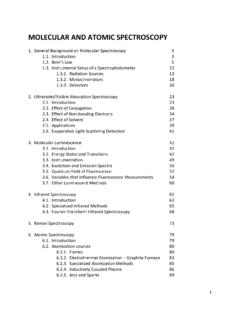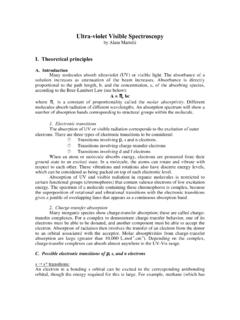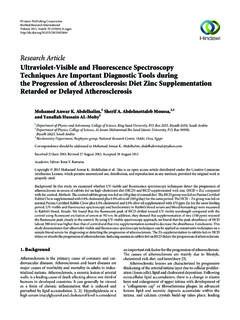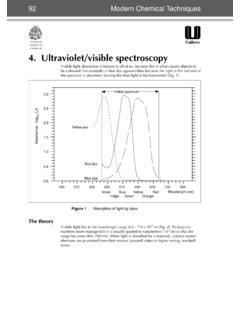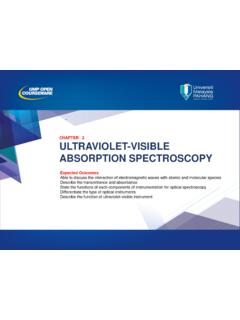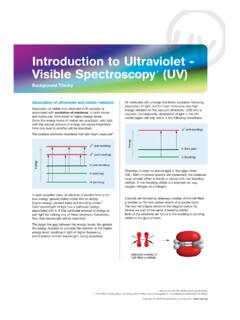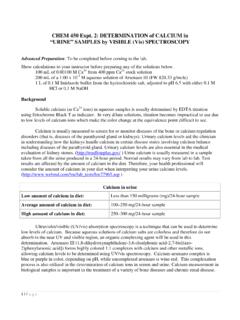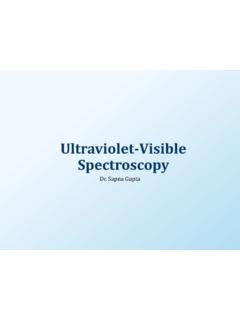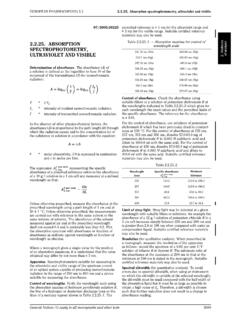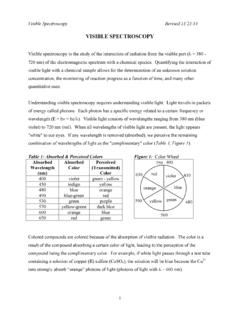Transcription of Experiment 2: INTRODUCTION TO SPECTROSCOPY
1 CHEM 15151 Spring 2002 Name _____Section _____Experiment 2: INTRODUCTION TO SPECTROSCOPYPRE-LABORATORY QUESTIONS1. a. Define What type(s) of molecular motion are stimulated by microwave radiation? Infraredradiation? visible radiation?c. What type of radiation will be used in this Experiment ?2. a. Define percent transmittance and How do you mathematically convert between the two?The following preparation questions should be answered before coming to lab. They areintended to introduce you to several ideas important to aspects of the Experiment . Youmust turn in your work to your instructor before you will be allowed to begin 15152 Spring 20023. What is the purpose of the blank solution?4. What is max?5. a. State Beer s Law mathematically and define each What important information about an analyte in solution can be determined fromBeer s Law Plot?CHEM 15153 Spring 2002 Experiment 2: INTRODUCTION TO SPECTROSCOPYIn Part One of this Experiment you will be introduced to the fundamentals of SPECTROSCOPY .
2 Youwill first learn how to properly use a Spectronic 20 instrument and then you will use the instrumentto find the wavelength ( ) at which absorbance of light by a solution of food coloring agent has amaximum value ( max). In Part Two you will learn how a law of SPECTROSCOPY , termed Beer s Law,can be used to determine the concentration of food coloring in an unknown this Experiment you will do the following:1. Learn to use the Spectronic 20, a spectrophotometer. (Part One)2. Find max for two different food coloring solutions.(Part One)3. Prepare food-coloring solutions of various known concentrations by diluting a stockstandard solution. (Part Two)4. Set the Spectronic 20 at the value of max obtained in Part One, and then generate acalibration curve that relates absorbance to concentration. (Part Two5. Use the calibration curve and the Spectronic 20 to determine the concentration of anunknown.)
3 (Part Two)INTRODUCTIONThe word SPECTROSCOPY is used to refer to the broad area of science dealing with the absorption,emission, or scattering of electromagnetic radiation by molecules, ions, atoms, or techniques are some of the most widely used analytical methods in the world techniques are useful in determining both the identity of unknown substances and theirconcentration in solution. Different regions of the electromagnetic spectrum such as infrared, visible , ultraviolet , or, X-ray radiation can be used to interact with matter. The Spectronic 20instrument you will use can correctly be called a colorimeter, because it measures the absorptionof light in the visible spectrum that we perceive as color, and the technique used is said to electrons and nuclei of atoms and molecules may exist in only certain specific energy levels,that is, they area quantized. They can absorb only photons having certain energies or energies of light absorbed by a molecule can be related to motions (energy modes) of themolecule.
4 A few examples are shown in Table MotionAbsorbed Electromagnetic RadiationEnergyRotationMicrowave, infraredLowVibrationinfraredModerateElec tron transitions visible , ultravioletHighCHEM 15154 Spring 2002 Although the instruments that are used to measure the interaction of various regions ofelectromagnetic radiation with matter differ a great deal in design and operation, they all containthe same basic components. A schematic diagram of a simple instrument that is used to measurethe absorption of visible light is shown in Figure source provides the electromagnetic radiation that will be absorbed by the sample. It is oftensome sort of light bulb or lamp. The monochromator selects one particular energy (or wavelengthor color) of light from the source. A prism, a diffraction grating or a colored filter together withslits and mirrors can serve as a monochromator.
5 (A diffraction grating consists of a large numberof closely spaced lines etched on a highly polished surface. The lines act as scattering centers forthe incoming radiation, separating white light into the colors of the rainbow). The detectormeasures the amount of light that passes through the sample. A phototube (or photo cell) orphotomultiplier is often used as a detector. All of these work on essentially the same falling on the surface of the detector causes current to flow in a surrounding electricalcircuit. The amount of current in the circuit is proportional to the amount of light striking the parts of the instrument work together as follows (Figure 1): Light from the source passesthrough the monochromator producing a beam with a single energy or a narrow band of intensity of this beam, I0, is measured by the detector. The sample is then placed in the beambetween the monochromator and the detector.
6 If some of the light is absorbed by the sample, theintensity of the beam reaching the detector, I, will be less than I0. The detector compares the twointensities and reports the result as either percent transmittance (%T) or absorbance (A).These terms are defined to be: %T = I/ I0 x 100(the fraction of I0 that gets through the samples is called Transmittance) A = - log T = -log (I/ I0) = 2 log (% T)CHEM 15155 Spring 2002If the monochromator is a prism or a diffraction grating, all of the energies (or wavelengths) areavailable and may be do not absorb all wavelengths equally well. Consider a colored object. Human sight isthe brain s interpretation of photons of electromagnetic radiation in the Visual range (light)entering the eye. If all the energies (wavelengths, colors) are mixed they are perceived as whitelight.
7 If no photons at all enter the eye we "see" black. A color is perceived if only photons of oneenergy (light of one color, monochromatic light) enters the eye or if photons of a complementarycolor are missing from the usual white light mix. A white object then appears to be white becauseit does not absorb any of the light that strikes it. A black object looks black because it absorbs allof the incident light. A rose looks red if it absorbs all the light except the red or if it absorbs thelight of the color complementary to red - that is, blue-green. Table II shows a brief list of colorsabsorbed to give observed II. visible Spectrum and Complementary Colors*Wavelength , nmColor ( Absorbed)Complementary (Observed)400 435 VioletYellow-green435 480 BlueYellow480 490 Green-blueOrange490 500 Blue-greenRed500 560 GreenPurple560 580 Yellow-greenViolet580 595 YellowBlue595 610 OrangeGreen-Blue610 750 RedBlue-GreenIn order to achieve the most accurate results in Part Two in which we will determine theconcentration of a colored species in solution, we need to maximize the absorptivity of the species(Part One).
8 We must select the color (energy, or wavelength) of light from our source that is bestabsorbed by the molecule. For example, if a solution is green-blue, it will absorb orange light, andthe wavelength of maximum absorbance, max, will fall between 595 and 610 nm (see Table IIabove). Amounts of light absorbed, even in the case of concentrated solutions are very smallcompared to the amount of light available from the source. It is much easier for the instrument to"see" the change if we make it as large as possible. Most spectrometers have variablemonochromators such as a prism or diffraction grating, making it is easy to select thecomplementary color from the source by stepping through the available wavelengths and plottingthe absorbance (or percent transmittance) versus the wavelength manually or let the instrumentscan through the range the plot (spectra) we can determine the exactwavelength of the complementary color, which is the wavelength of the maximum absorbance( max).
9 Values for max of many substances can be found in the chemical literature.*Day, R. A., Jr., and A. L. Underwood. Quantitative Analysis, 3rd ed. (Englewood Cliffs, NJ: Prentice-Hall,Inc.), 15156 Spring 2002 PROCEDUREPART ONE:OPERATION OF THE SPECTRONIC 20 AND DETERMINATION OF maxEquipment Needed From The Storeroom2- Spec 20 tubesA. Operation of the Spectronic 20 The Spectronic 20 is a moderately expensive piece of scientific equipment and should betreated with all due care and IIIn all the instructions that follow refer to Figure Instructions (Use with Parts One and Two Below.)1. The Spec 20 is turned on by rotating the power switch, 1, until a click is heard and thepilot lamp,3, comes on. The instrument must war,m up for about 30 minutes prior Use knob 4, the wavelength control, to set the desired wavelength. (in Part One the firstwavelength will be 340 nm; in Part Two, the wavelength you use will be max that youdetermined in Part One.)
10 CHEM 15157 Spring 20023. With the sample holder, 2, empty, close the door and set the readout scale to 0 %transmittance ( absorbance) using knob 1. Be sure to line up the needle with itsreflection in the mirror when reading the Obtain a Spec 20 sample tube. The tube may look like an ordinary test tube, but it ismade of special high quality glass and is much more expensive ($ each!). Clean thetube and rinse it with distilled water, and then fill the tube about 3/4 full of blanksolution (the blank is distilled water in this Experiment ). Carefully wipe away anysolution and fingerprints from the outside of the tube using a Open the lid of the sample holder, 2, and slide the sample tube into the opening. Find thehash mark (small straight line) on the tube and line it up exactly with a similar mark onthe sample case. Close the With the blank solution in the sample case, set the read-out scale to 100% transmittance(0 absorbance) with knob Remove the tube from the sample case and close the door.




